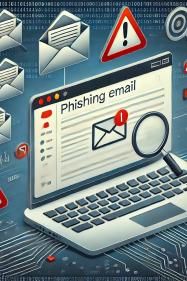Phishing emails are a common cyber threat that can lead to serious consequences, such as data theft and financial loss. Cybercriminals craft these emails to deceive recipients into clicking on malicious links or providing sensitive information. Understanding various phishing email examples can help you identify and avoid potential threats. At Arsen, we provide next-generation awareness training to equip employees with the knowledge to spot these scams. Here are some examples of phishing emails and tips on how to prevent falling victim.
1. The "Unusual Activity Detected" Scam
Example
You receive an email claiming to be from a well-known service, such as your cloud storage provider. The subject line reads: "Unusual Activity Detected on Your Account." The email states that there have been multiple failed login attempts and urges you to "secure your account" by clicking a link to verify your identity.
The link leads to a website that looks nearly identical to the provider’s legitimate login page, prompting you to enter your username and password. Once you input your credentials, they are sent directly to the attacker.
Prevention Tips
Verify the Source: Before clicking on any link, verify the sender's address. Official companies use standard domain addresses (e.g., "@serviceprovider.com"). If the sender’s address appears suspicious or contains slight misspellings, do not engage with the email.
Access Accounts Directly: Never click on links in unsolicited emails. Instead, visit the website by typing the URL directly into your browser and logging in through the official site to check for any account issues.
2. The "Invoice Attached" Scam
Example
You receive an email from an unknown sender with the subject line "Invoice for Payment." The message claims to be a follow-up on a previous transaction and includes an attachment labeled "Invoice_1234.pdf." The sender urges you to open the attachment to view payment details.
If you open the attachment, it may contain malware that infects your device, allowing the attacker to access personal files, monitor your activity, or steal sensitive information.
Prevention Tips
Be Wary of Unexpected Attachments: Do not open attachments from unfamiliar senders or unexpected emails. Even if the sender appears to be known, verify the legitimacy of the message by contacting them through a different communication channel.
Use Anti-Malware Software: Ensure your device has updated antivirus software to detect and block malicious attachments. Most modern antivirus solutions can scan attachments for potential threats.
3. The "Security Alert" Email
Example
A phishing email arrives with the subject line: "Security Alert: Suspicious Login Detected." The message appears to be from your email provider and claims that someone has accessed your account from an unknown device. It urges you to click a link to "review the login attempt."
The link leads to a fake login page designed to capture your credentials. By logging in, you inadvertently give the attacker access to your email account, which can be used to reset passwords for other online services.
Prevention Tips
Hover Over Links: Before clicking any link, hover over it to reveal its destination. If the URL looks suspicious or does not match the official website of the company, do not click.
Enable Multi-Factor Authentication (MFA): MFA adds an extra layer of security to your accounts. Even if an attacker obtains your password through phishing, they will need the second authentication factor (e.g., a code sent to your phone) to access your account.
4. The "You've Won a Prize!" Scam
Example
An email claims you’ve won a gift card, lottery, or prize from a contest you never entered. To claim your reward, the message asks you to click on a link and provide personal information, such as your name, address, and credit card details for "verification purposes."
Prevention Tips
Be Skeptical: If an offer seems too good to be true, it probably is. Legitimate companies do not request sensitive information to claim a prize, especially through email.
Report Suspicious Emails: Report phishing attempts to your IT department or email provider to prevent others from falling victim to similar scams.
Final Thoughts
Phishing emails can take many forms, from security alerts to fake invoices and prize notifications. Recognizing these phishing email examples and understanding their tactics is crucial for protecting your information. By verifying the source, avoiding unexpected attachments, and using multi-factor authentication, you can significantly reduce the risk of falling victim.
At Arsen, we provide advanced training to help employees identify phishing attempts and implement best practices to secure their communications.

